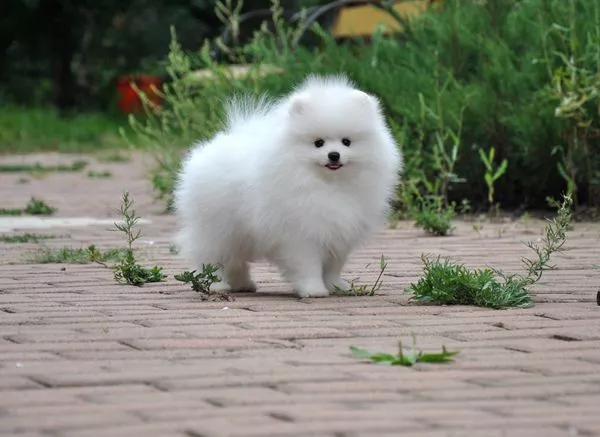Pomeranians are a popular toy breed known for their adorable appearance and playful personalities. One of the most distinctive features of Pomeranians is their thick, fluffy fur, which makes them look like tiny balls of fluff. However, there is more to Pomeranian fur than just its cuteness. Understanding the anatomy of Pomeranian fur is essential for proper care and grooming of this breed. In this article, we will explore the layers and characteristics of Pomeranian fur.
The Basics of Pomeranian Fur
Pomeranians have a double coat, which means they have two layers of fur. The outer layer is long, straight, and fluffy, while the undercoat is soft, thick, and short. The purpose of the double coat is to protect the dog from the cold and keep it warm. The outer layer repels water and dirt, while the undercoat provides insulation and helps regulate body temperature.
The texture of Pomeranian fur is soft and silky, with a slight wave or curl. The fur is known for its ability to trap air, which helps to insulate the dog against the cold. Pomeranian fur comes in a wide range of colors, including black, white, cream, orange, red, sable, and brindle. Some Pomeranians have a parti-color coat, which means their fur is a combination of two or more colors.
The Layers of Pomeranian Fur
As mentioned earlier, Pomeranians have a double coat consisting of two layers of fur. Let’s take a closer look at each layer.
The Outer Layer
The outer layer of Pomeranian fur is the longer, coarser, and more visible layer. It is made up of guard hairs that protect the dog from the elements. The guard hairs are straight and have a slight wave or curl at the end. The outer layer is also responsible for giving Pomeranians their fluffy appearance.
The Undercoat
The undercoat of Pomeranian fur is the shorter, softer, and denser layer. It is made up of fine, downy hairs that provide insulation and help regulate body temperature. The undercoat is responsible for keeping Pomeranians warm in cold weather. It also sheds seasonally, which means that Pomeranians will lose their undercoat twice a year, usually in the spring and fall.
Characteristics of Pomeranian Fur
Pomeranian fur has several unique characteristics that make it different from other types of fur. Let’s take a closer look at some of these characteristics.
Thickness
Pomeranian fur is thick and dense, which helps to insulate the dog against the cold. The undercoat is particularly thick, and it is responsible for keeping Pomeranians warm in cold weather. However, the thickness of Pomeranian fur also means that it can be prone to matting and tangling if not properly groomed.
Silkiness
Pomeranian fur is soft and silky to the touch, with a slight wave or curl. The texture of the fur is one of the breed’s most distinctive features and is often compared to that of a plush toy. The silkiness of Pomeranian fur also means that it can be prone to static electricity, which can cause the fur to stand up and look frizzy.
Color
Pomeranian fur comes in a wide range of colors, including black, white, cream, orange, red, sable, and brindle. Some Pomeranians have a parti-color coat, which means their fur is a combination of two or more colors. The color of a Pomeranian’s fur is determined by genetics and can be influenced by factors such as diet and environment.
Grooming Pomeranian Fur
Proper grooming is essential for maintaining the health and appearance of Pomeranian fur. Here are some tips for grooming Pomeranian fur:
Brushing
Regular brushing is essential for preventing matting and tangling of Pomeranian fur. Use a slicker brush to gently brush the fur in the direction of growth. Avoid pulling or tugging on the fur, as this can be painful for the dog. Brushing should be done at least once a week, and more frequently during shedding season.
Bathing
Pomeranians do not need to be bathed frequently, as this can strip the fur of its natural oils. However, occasional baths are necessary to keep the fur clean and healthy. Use a mild dog shampoo and rinse thoroughly to avoid leaving any residue on the fur.
Trimming
Trimming is necessary to keep the fur around the face, feet, and anus clean and neat. Use scissors or clippers to trim the fur, being careful not to cut too close to the skin. If you are not comfortable trimming the fur yourself, take your Pomeranian to a professional groomer.
Conclusion
In conclusion, understanding the anatomy of Pomeranian fur is essential for proper care and grooming of this breed. Pomeranians have a double coat consisting of an outer layer of guard hairs and an undercoat of fine, downy hairs. The fur is thick, silky, and comes in a wide range of colors. Proper grooming, including regular brushing, occasional bathing, and trimming, is necessary for maintaining the health and appearance of Pomeranian fur. With proper care, Pomeranian fur can be a beautiful and distinctive feature of this adorable breed.


